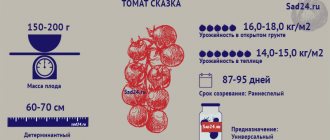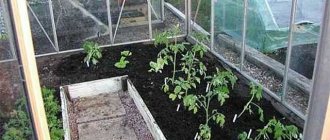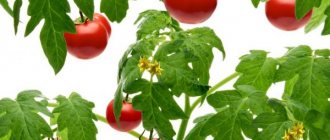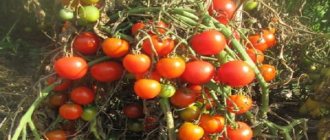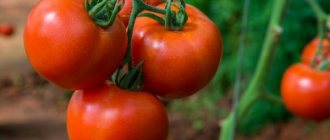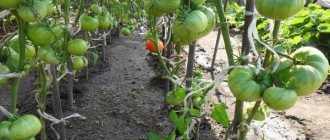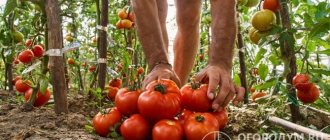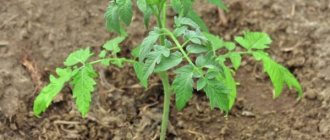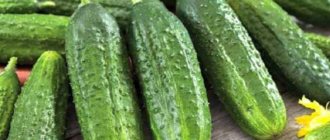Tomato “No worries, no hassle” - description and characteristics of the variety
A tomato variety with the interesting name “No worries, no hassle” was grown in the Urals. Breeders tried to create a species that meets all the wishes of vegetable growers, the main of which are: high yield levels, ease of care, resistance to diseases and pests. Each time the new hybrid obtained has certain advantages over its “ancestors”.
The variety “No worries, no hassle” is a successful attempt to create the “ideal” type of tomatoes for every gardener and for almost any climatic conditions.
Description
The variety “No worries, no hassle” belongs to the early ripening varieties. At first it grows in small boxes and containers, and only then is it placed in open ground or a greenhouse for a permanent place of growth.
The plant can reach a height of up to half a meter. Due to its compact size, it does not need to be tied to a support or remove excess branches. All this makes care much easier. Juicy bright red fruits have a smooth, oval elongated shape. The weight of one tomato reaches from 50 to 70 grams. All specimens are fleshy, with juicy pulp.
This variety is ideal for beginners in vegetable growing, as it does not require special care or skills. The plant can be planted quite early, as it is resistant to low temperatures. In this regard, it is possible to obtain high yields long before the end of the season and not worry about such a scourge as late blight.
Growing the variety
Growing “No worries, no hassle” tomatoes in general is not very different from growing other varieties. The growing process consists of the following stages:
- Already in early spring it is worth planting seeds; they are placed in the ground at a shallow depth of 1 cm.
- When the plant has a couple of true leaves, a dive is carried out.
- In the initial period of growing seedlings, inorganic fertilizers are actively used.
- 7 days before planting in a permanent place of growth, a special procedure is carried out to harden the plants - for this they are 5) Periodically taken out into the open area, this can be a balcony.
- As a rule, in late May - early June, grown seedlings are planted in beds or in a greenhouse. At this point, at least one full-fledged brush or 6 to 7 true sheets should have formed.
- Tomatoes are planted according to the 30x50 pattern.
- Experienced vegetable growers strongly advise using only warm water for irrigation. The best time to moisten the soil is in the evening, after sunset.
- Plants need to be fertilized throughout the entire period of growth and development.
Features of cultivation
Experienced vegetable growers recommend temporarily germinating seed material. Germination is carried out according to the classical scheme:
- Processing.
Ant. seed infection. Disinfection is carried out using a weak solution of manganese. - Scattering.
The seeds are placed in a container with a nutrient mixture to a depth of 1-2 cm. - Flooding.
Watering is moderate, using a spray bottle. - Lighting.
Seedlings need bright, diffused light. - Liquidus.
The room temperature should not fall below 18 degrees Celsius.
The age of seedlings transplanted to a permanent place of growth must be at least 2 months. On 1 square meter, landing of 3 young plants is allowed.
Features of planting and growing tomato Siberian miracle
Siberian Miracle is a typical indeterminate variety of medium ripening, and all its agricultural technology is completely subject to this definition. Moreover, it completely forgives minor flaws of inexperienced gardeners, while practically not sacrificing productivity. This is one of the most unpretentious tomatoes in the Barnaul collection; in terms of unpretentiousness, it is not inferior to other Siberian varieties, including the selection of the Novosibirsk team of V.N. Dederko.
As usual, seeds for seedlings are sown in boxes a little over two months before the plants are supposed to be transplanted into the garden bed. After germination, the seedlings are kept cool, then at room temperature. Water moderately, try to do without fertilizing. Despite the cold resistance of the variety, a week before planting, the seedlings are gradually accustomed to outdoor conditions.
In unprotected soil, three bushes are planted per 1 m2; in a greenhouse, in order to save space, four can be done. Be sure to drive in stakes, and if possible, set up a trellis for tying up the stems. Usually the Siberian miracle is formed into one or two stems, the stepsons are systematically removed. Failure to comply with these conditions, of course, will not destroy the plants, but will to some extent reduce the yield. In August (the beginning of the month in open ground and the middle in a greenhouse), the top of the stem is pinched, leaving two leaves above the last fruit cluster formed.
When forming plants, they try to adhere to classical patterns.
Moderate watering, three standard feedings per season and keeping the soil loose are the usual requirements for growing tomatoes. If we are talking about a greenhouse, it should be ventilated in a timely manner. The Siberian Miracle variety tolerates elevated temperatures normally, but their combination with high air humidity is fraught with the occurrence of fungal diseases. And although the variety has good immunity, it is better not to take risks. In the event of a sharp autumn cold snap, the fruits of the Siberian miracle can be harvested unripe; their quality when ripened indoors will be almost the same as when ripened on the bushes.
Characteristics of the lazy tomato
The Lazy Tomato is a hybrid obtained by Siberian breeders. The variety was bred under the Siberian Garden brand; Novosibirsk is considered its homeland. In the southern and central regions, the plant produces consistently high yields in open beds under conditions of abundant, constant watering. In the Urals and Siberia, tomatoes are grown only under film cover.
Despite its young age, it has gained great popularity among beginning gardeners, as it is unpretentious, does not require shaping, tolerates minor frosts, and can grow in open beds and under film.
Productivity and fruiting
The Lazy Tomato is a high-yielding hybrid. The first harvest appears in the third month after seed germination. If the rules of care are followed, the bush yields up to 6 kg; when grown in regions with an unstable climate, the yield is reduced to 3 kg. The total fruiting per square meter is about 15 kg.
The Lazy Tomato is suitable for growing in open beds and in a greenhouse. The yield is influenced by climatic conditions, regular watering and fertilizing, loosening the soil and removing weeds. Harvested tomatoes retain their freshness, taste and marketability for a long time.
Important! The hybrid Lazyr has a friendly and extended fruiting, the fruits can be collected before the first cold weather
Area of application of fruits
Lentyayka tomatoes are universal in use. Suitable for preparing spring salads and canning for the winter. Thanks to their juicy pulp, tomatoes are ideal for making freshly squeezed drinks, sauces and adjika. Tomatoes can also be consumed in sun-dried and dried form. Dried tomatoes are considered an excellent addition to meat dishes and are suitable for making pasta and sauces. Due to their large size, the fruits are not intended for whole canning.
Resistance to diseases and pests
The Lazy Tomato is resistant to late blight and macrosporosis, but insect pests such as mole crickets and slugs often appear on it. To protect bushes from diseases, you need to follow the rules of care, carry out regular ventilation and preventive measures.
Important! Often the fungus affects bushes and fruits growing under film cover. The first fruits can reach up to 500 g
The first fruits can reach up to 500 g
The first fruits can reach up to 500 g
Main types of tomatoes
Depending on their growth, tomatoes are divided into several types:
- standard,
- indeterminate,
- semi-determinate,
- determinant.
Let's take a closer look at each variety.
Standard
These are the shortest tomatoes, distinguished by their compact bush size and thick stem. Standard varieties are not the most productive varieties; their main advantage is their early ripening.
The main advantages of the type include:
- resistance to adverse factors - drought, frost;
- thick stem, thanks to which the plant does well without tying;
- tight fit due to compact size;
- shallow roots, allowing active absorption of water and additional nutrients;
- good transportability of fruits.
Standard crops are grown mainly in greenhouses and greenhouses; it is advisable to plant them in open ground only in the southern regions.
Standard varieties include the following varieties:
- Cameo is an early-ripening variety with smooth fruits, juicy pulp and a pleasant aroma.
- Buyan - the average weight of cylindrical fruits is 90 g. Excellent for preservation, resistant to the vagaries of weather, tobacco mosaic.
- Yamal is characterized by increased resistance to diseases and pests. With proper care, you get a good harvest of dense, rounded fruits weighing 70-100 g.
Indeterminate
The stem of indeterminate tomatoes reaches 2-4 m in height, so varieties must be tied up. To limit the plant's growth, pinch the top of the stem. This variety is characterized by long-term fruiting; in heated greenhouses, the plant bears fruit throughout the year.
Advantages:
- high yield - 14-17 kg/m²;
- stable immunity to fungal diseases and the vagaries of nature.
The disadvantages include the mandatory strict adherence to the rules of agricultural technology, especially when forming a plant bush.
Among the many indeterminate crops there are:
- Angel F1 is a new domestic hybrid without restrictions on the region of cultivation, early ripening, for salad purposes. It is characterized by high productivity, good immunity to fusarium and verticillium.
- Belfast F1 is a popular early-ripening hybrid, immune to cladosporiosis, fusarium, tobacco mosaic, and tolerates transportation well. The fruits weigh an average of 210 g, do not crack, and the yield is high - up to 26 kg/m².
Tomato Angel F1
Other indeterminate varieties and hybrids are Walford's Miracle, Crushed Heart, Tyler f1, Lion's Heart, Star of Siberia.
Semi-determinant
Semi-determinate plants stop growing at about 10-12 inflorescences, are characterized by high productivity, do not require complex care, and are suitable for greenhouses and open ground.
A distinctive feature of the species is short internodes.
Among the many semi-determinate varieties are:
- Magnus is an early variety with tasty fruits and is considered ideal for canning.
- Silhouette is a greenhouse hybrid; its small fruits are perfectly stored and transported.
- Red Arrow is one of the most unpretentious varieties, suitable for canning and summer salads, and is characterized by high yield.
- Zinulya is a mid-season variety with large and sweet fruits.
Tomato Magnus
Determinant
Determinate tomatoes are varieties that stop growing when a cluster of flowers appears at the top. The height does not exceed 80 cm. They are grown everywhere: in the southern regions - in open ground, in other parts of Russia - in hotbeds and greenhouses.
Such plants bear fruit once per season for 1-3 weeks.
The main advantages of determinate tomatoes:
- precocity;
- high productivity;
- friendly return;
- low maintenance requirements;
- possibility of cultivation even in northern regions;
- suitability for canning.
The disadvantages are quite controversial - some vegetable growers consider determinate tomatoes less tasty.
The best varieties of determinate tomatoes:
- Alsou is a mid-early, large-fruited variety. Grown in open and closed ground, yield up to 9 kg/m². Used fresh and in salads.
- Gina TST is a mid-season variety that does not require pinching for film greenhouses and open ground. Resistant to cracking and disease, suitable for canning and fresh consumption.
- Lyubasha F1 is an ultra-early hybrid of universal use, resistant to cracking and disease, suitable for growing in open and closed ground. It has a high yield - up to 20 kg/m².
Tomato Alsou
Pest and disease control
The Lazy Tomato has strong immunity to diseases and pests. But if agrotechnical rules are not followed, the following may appear on the bush:
- Mosaic is a viral disease. In infected bushes, the foliage becomes covered with yellow spots and becomes wrinkled and curled. Without treatment, the plant becomes depleted, lags behind in development, and productivity decreases. Folk remedies can save the bush: dilute a liter of low-fat milk in a bucket of water, add 1 tsp. urea. Treatment is carried out once every 10 days in the morning or evening. When infected, the foliage dries out and curls.
- Brown spotting - appears when care rules are not followed. Brown spots and a grayish coating appear on the foliage. Without treatment, diseased tomatoes die. The initial stage of the disease - light spots on the foliage
- Mole cricket is a common pest that gnaws at the base of the stem. As a result, the bush dries out and dies. You can get rid of insects using an infusion of hot pepper and vinegar solution. The insect breeds in the soil
general characteristics
The pickling miracle is a simple, low-growing bush, no taller than half a meter, early ripening, with fruit ripening from three to three and a half months. It tolerates fluctuations in ambient temperatures well and is resistant to diseases and pests.
But still, you shouldn’t let the maturation of the bush take its course. Before sowing, the seeds must be kept in a disinfectant solution, then washed, dried and treated with growth stimulants. To repel the “invincible” Colorado potato beetle, bushes must be sprayed with special (safe for humans) poisons. The Salting Miracle copes with the rest of the harmful lovers of tomato leaves on its own.
- The fruits of “Lentyayka” tomatoes have a small, plum-like, dense shape and a rich red color. Two to three centimeters long and eighty to one hundred grams of weight per tomato from the first ripening, the rest of the offspring is smaller.
- The bush bears fruit densely; from just one you can collect a bucket of up to twenty liters.
- The pickling miracle, with its size and taste (without a sweetish aftertaste), is ideal for twisting whole fruits.
- The dense pulp of the fruit and durable skin retain its integrity well during transportation and pickling.
- The name of the tomato speaks for itself.
Diseases and pests
The Salting Miracle variety has excellent immunity. Tomatoes are resistant to tobacco mosaic virus, late blight, Alternaria blight, anthracnose and fusarium blight. The leaves and stems of tomatoes contain poisonous alkaloids, which is why most leaf beetles avoid them. The main pest is the Colorado potato beetle. He is attracted to young plants. During this period, you need to spray them with any insecticide.
The Salting Miracle variety was developed quite recently, but is already well known among those who like to prepare salted and canned tomatoes.
Tomato Miracle of Altai: characteristics and description of the variety, cultivation and care with photos
The Altai Miracle tomato was bred by specialists in the last years of the last century and today the plant is included in the state register of the best breeding achievements. Experts set themselves the goal of creating tomatoes that would be able to produce high yields in the climate of the Siberian regions. Thanks to the efforts of specialists, a variety appeared, called the Miracle of Altai. The description of the variety indicates possible cultivation in greenhouses and open ground conditions.
The characteristics of the tomato classify it as an interdeterminate type, that is, the growth of the main stem occurs constantly. In open ground, the height of the bush varies from 1.3 to 1.6 meters. In a greenhouse this value may be slightly higher. Due to its high growth, the plant must be tied up, and the supports must be higher than the height of the main trunks.
The plant has powerful trunks, characterized by good strength and a shade of emerald green foliage. The Altai variety has a good ability to set fruit at low temperatures. The bush can easily withstand the weight of the fruit and does not break, so additional tying of the clusters is not required.
Fruit characteristics
Reviews from gardeners confirm the excellent characteristics of the tomato. The first clusters form large-sized tomatoes, weighing on average from 300 to 350 grams. Greater fruit yield occurs in the second wave. The average weight decreases slightly and ranges from 150 to 200 grams. Unripe tomatoes have a small dark spot near the stalk, which disappears as the fruit ripens.
The fruits are rich red in color and have an oval shape. The vegetable pulp harmoniously combines density with tenderness and juiciness. The taste of the tomato is sweetish with a slight sourness. The number of chambers for seeds is on average from 5 to 7.
When and how does maturation occur?
Miracle of Altai belongs to the mid-season varieties in terms of ripening characteristics. The first fruits are harvested 90 days after the first shoots appear. Fruiting lasts a long time and is distinguished by its full yield. Clusters of tomatoes ripen in waves.
Tomato has a high yield. When growing in greenhouses, there are from 10 to 15 kg of vegetables per 1 m2. One plant bush on average brings from 4 to kg of vegetables. In open ground conditions, the yield is slightly lower, but under good weather conditions it can correspond to the values of greenhouse cultivation.
Advantages and disadvantages
The variety is unusually resistant to low temperatures and environmental factors. The seeds have a high germination rate, which reaches 99.8%, and the seedlings tolerate diving well. The ability to tolerate stress is superior to that of some hybrid varieties. Reviews from gardeners indicate the following advantages of the variety:
- has the ability for continuous growth, which does not stop even with a sharp temperature change;
- regardless of weather conditions, ovaries form;
- good yield indicators when grown not only in a greenhouse, but also in open ground conditions.
Due to such advantages, the variety provides excellent yields regardless of weather vagaries. Reviews from gardeners confirm the versatility of the variety. The ability to ripen in waves facilitates the processing of the crop. The only drawback is the plant's intolerance to waterlogging.
Nuances of cultivation
Growing and caring for the plant does not differ from generally accepted rules. It is recommended to adhere to the following tips:
- seedlings that are at least 2 months old are planted in the ground;
- The planting scheme assumes 3 seedlings per 1 m² for open ground, 4 for greenhouse conditions;
- the plant needs tying and pinching;
- bushes must be provided with sufficient ventilation.
Periodic spraying with preparations, soil disinfection and crop rotation will help rid the plant of pests and traditional tomato diseases. Reviews from gardeners indicate the possibility of obtaining a good harvest with minimal time and effort.
a brief description of
The “Siberian Miracle” tomato grows in open ground to a height of 1.3-1.6 m. When grown in greenhouse conditions, this figure may be slightly higher. The trunks are powerful and durable, the foliage is large, emerald green.
Fruits set in any weather. And even with sudden temperature changes, the tomato set is at its best. The fruits set and pour quickly and smoothly.
Tomatoes are interdeterminate plants, meaning the main stem grows continuously.
“The Siberian Miracle” will delight gardeners with high yields in hot weather, with slight cooling, in greenhouses or open ground.
When growing tomatoes outdoors, the plants must be tied to long stakes or a strong trellis installed in the garden bed. The height of the supports should reach at least 1.5-1.7 m. When growing tomatoes in greenhouse conditions, you should also not forget about the garter.
Tomato fruit clusters do not break and therefore do not require personal garter or support. They are strong enough to bear the weight of the fruit.
Distinctive qualities of fruits
In the first two clusters, the tomatoes are formed quite large, sometimes their weight reaches 300-350 grams. They look appetizing, have an oval shape, bright red color with a raspberry tint. Tomatoes collected in the first wave are perfect for cutting fresh salads.
Interesting! Thanks to the simplicity of agricultural technology, high yields and advantages, tomatoes can be grown both in private plots and on farms.
The pulp of tomatoes of the “Siberian Miracle” variety is ideal, it is dense and tender, moderately juicy, but the dry matter content in tomatoes reaches 6%. In terms of taste, the indicators are also excellent - sweet, with a slightly noticeable sourness. Number of seed chambers 5-7 pcs.
During the second wave of harvest, the so-called mass harvest, the weight of tomatoes is much less, 150-200 grams. The fruits are egg-shaped and ripen together.
Unripe tomatoes are light green in color; the fruit has a dark spot near the stalk. During the ripening process, the stain disappears completely.
Tomatoes are excellent at transporting over short distances while maintaining their taste and presentation. For long-distance transportation, it is recommended to harvest slightly unripe.
Features of maturation
The tall tomato “Siberian Miracle” is a mid-season variety. The first harvest can be harvested 90-110 days after the appearance of the first shoots. A long period of fruiting is characterized by the full production of tasty tomatoes of excellent quality and excellent presentation.
Fruit clusters ripen in waves; overall yield indicators can please even experienced vegetable growers. When grown in greenhouse conditions, from 1 m² you can harvest up to 10-15 kg of tomatoes during the entire fruiting period, and from one bush the yield reaches 4-6 kg.
When grown in open ground, this figure may be a little more modest. And again, it all depends on what surprises the weather brings.
In mid-August - early September, summer residents remove unripe tomatoes from plants grown in open ground. They ripen well at room temperature and retain their taste for a long time.
Interesting! Tomatoes contain large amounts of “serotonin,” the so-called happiness hormone that improves mood.
Siberian wonders of endurance
In terms of its resistance to stress factors, the tomato really lives up to its sonorous name. They are not only not inferior, but in many ways superior to many hybrids. As a rule, hybrid varieties, due to certain goals pursued during their creation, are intended for special growing conditions. Greenhouse plants tolerate high temperatures well, while soil plants tolerate low temperatures.
Tomatoes of the “Siberian Miracle” variety are flexible:
- They do not stop growing and grow well even with sudden changes in ambient temperature;
- They bloom and form ovaries in any weather;
- Capable of producing an excellent harvest both in open and closed ground.
These qualities guarantee the stability of high yields every year, despite the vagaries of the weather.
The description and characteristics of the “Siberian Miracle” tomato only confirm its versatility.
Care
The Miracle of Altai variety does not require special care. When growing tomatoes of this type, you must adhere to the general rules:
- Watering.
Moderate, regular irrigation is necessary. - Introduction of fertilizers.
Vegetable growers recommend introducing mineral fertilizers during flowering and fruit formation. - Chiselization of the soil.
Regular loosening of the soil will prevent the development of microorganisms that can adversely affect the plant. - Removing weeds.
To prevent soil oxidation, regularly weed the beds. - Stepsonning.
The plant needs pruning. - Ventilation.
When growing a variety in a greenhouse, it is recommended to systematically ventilate the room. - Treatment.
To avoid the occurrence of diseases that can be detrimental to the plant, the bushes are regularly treated with special preparations. - Addition of fruits.
Ripe fruits must be collected in a timely manner, so as not to inhibit the development of new ovaries.
The Altai Miracle tomato received the praise of experienced vegetable growers. This variety is grown in many summer cottages and has a lot of positive reviews.
Characteristics of the variety
One of the main advantages of such tomatoes is their resistance to cold. Therefore, No worries, no hassle is ideal for growing in climates that are considered risky for farming.
It is important to grow these fruits only from seedlings. Tomatoes are transplanted to a permanent place with the onset of warm weather, that is, no earlier than May.
If we are talking about a region with a harsh climate and capricious summer weather, then you should definitely cover the bushes with film.
The variety No worries, no hassle is well suited for growing both in a greenhouse and in open ground. Productivity does not depend on the place of cultivation (with proper care).
Another positive quality of tomatoes of this variety is that they are not tall. This is a determinate variety that does not grow to large sizes. Considering that the bushes will be located at a fairly short distance from the ground, they are not afraid of a sharp but short-term cold snap.
The small size of the plant also means that there is no need to tie up the bushes. Moreover, tomatoes do not require any worries or hassle for shaping and pinching, that is, removing excess branches to enhance the growth of the main trunk.
Growing rules
To get seedlings, you need to plant the seeds several months before planting in open ground. In order for them to sprout faster, you should regularly ventilate the room and carefully feed the soil. Organic matter is best suited for these purposes: regular use of droppings or wood ash will allow seedlings to sprout faster.
Seedlings should be planted in heated soil. Its temperature should not be less than 15°C. For 1 sq. m it is permissible to place about 5 bushes. Planting is carried out in such a way that there is a distance of 70 cm between the rows. Between the holes should not exceed 35 cm.
Characteristics and description of the tomato variety Medovo sugar (Honey dew)
One of the main advantages of any cultivated plant is its resistance to unfavorable climatic conditions. Siberian breeders developed the Honey dew or Honey dew tomato. It bears fruit successfully even in cold summers.
General description of the variety
The plant is suitable for growing in greenhouse conditions and open ground. The choice depends on the climatic conditions of the region. Appearance and description of the variety:
- mid-ripening, fruit ripening time up to 115 days;
- medium-sized, maximum height of bushes 1.5 m;
- high yield, maximum weight of berries from one bush is 3 kg;
- the maximum number of brushes on one plant is 7 pieces;
- suitable for transportation and storage;
- determinate bushes;
- resistant to most pests and diseases;
- requires careful care.
Reviews from gardeners indicate the successful cultivation of the plant in different parts of the country. Good results were recorded even in the coldest regions: Siberia, Khabarovsk, Irkutsk, Magadan region. The popularity of the Honey Sugar variety of tomatoes is due not only to its endurance, but also to the taste of the fruit. Characteristics of ripe berries:
- round shape;
- color creamy yellow when ripe;
- smooth;
- medium size, maximum weight 300 grams;
- sweet, honey taste.
Tomatoes of the Honeydew variety are often included in children's and diet menus. To successfully grow tomatoes, you must first prepare them - grow seedlings.
Preparing seedlings and planting
To get a good harvest, it is better to plant tomatoes in seedlings. If you follow the recommendations, there will be no difficulties with the plant:
- preparatory work begins two months before the expected landing date;
- Seeds should be planted at a depth of 1.5-2 cm;
- Separate peat pots are suitable for seedlings;
- it is necessary to maintain the room temperature at least 23 degrees;
- to improve germination, it is recommended to use a growth stimulator;
- love abundant watering;
- growth requires a constant source of light.
It is recommended to harden off the seedlings a week before planting. Place the plants in fresh air, start the hardening time at 20 minutes and increase to at least 2 hours.
Important! When planting in the ground or greenhouse, do not place the seedlings close to each other. For 1 sq.
m there should not be more than three bushes.
The plant requires mandatory pinching. For best results, the bush should be formed into one stem.
Features of tomato care
Tomatoes require moderate attention. The rules of care include:
- watering with warm water at least once every five days;
- weeding, it is necessary to remove weeds;
- loosening;
- Feed the plant with mineral or complex fertilizer at least 4 times from the moment of planting.
Gardeners' opinion about the variety
I really liked the sweet tomatoes of the Honeydew variety. I grew it especially for a child, on the recommendations of a friend. My daughter eats it with pleasure - she has no allergies, I prepare salads and wrap them. The variety turned out to be not very whimsical in cultivation. The main thing is not to plant seedlings too close.
Tomatoes love space and good feeding. Over the summer I fertilized the bushes five times. In warm summers I harvest a good harvest, 4 kg per bush. A ripe tomato of a very beautiful honey color, regular shape, smooth. They withstand transportation well and can be stored for a long time. We eat our fresh tomatoes until the end of November.
I'm happy with the variety, I recommend it!
Valentina Karlovna, 35 years old.
I planned to make some beautiful preparations for winter. It took me a long time to choose the right tomatoes. According to the description, I liked the Honey Sugar tomatoes, the color and size are suitable for twists. The first harvest was harvested in August.
The ripe berries lived up to expectations. All of the correct shape, smooth, neat, the color is very beautiful - honey. Ripe tomatoes taste sweet with a slight sourness. I grew the variety in a greenhouse, there were no particular difficulties.
One of the features is mandatory stepsoning.
The bushes turned out to be tall, I tied them up. Everything else is the same as with other varieties - watering, loosening, feeding. The twists were a success; in the winter we will treat ourselves to pickles. Next year I plan to try planting the variety in open ground if the summer is warm. I will definitely share my impressions.
Ekaterina Maslyakova, 47 years old.
Miracle variety tomatoes: description
Miracle tomatoes are a whole group of varieties; There are about 30 different subspecies on sale. All this diversity definitely has one thing in common: each variety is designed to surprise you with shape, yield, color or taste. It is thanks to their expressive qualities that this group of varieties got its name.
Characteristics of tomatoes of the Miracle variety
Varieties of Miracle varieties
The first thing the description of this crop says is the fact that the Miracle tomato family includes several varieties. And each of which has its own special characteristics:
Podsiny
Tomato Podsinsky miracle is a mid-season variety of unlimited growth. Its fruits are large, weighing up to 300 grams, with a plum-like shape. The pulp is fleshy and juicy with a small amount of seeds, good for salads, juices and especially sauces.
To maintain high yields, grow the variety in a greenhouse and form the bush into two stems. During the season, you can harvest up to 5 kilograms of tomatoes from a plant.
The Podsinsky miracle is suitable for growing in the regions of Siberia, Altai, and other areas with an unfavorable climate.
North
Severnoe is an early ripening variety; the harvest is harvested just 100–110 days after the first shoots. Fruits abundantly, forming 4–5 pear-shaped tomatoes in a cluster and weighing up to 100 grams.
The consistency of the fruit is fleshy and dense, excellent for preservation. Suitable for outdoor and greenhouse cultivation.
It feels great in harsh areas and grows remarkably in the Altai and Transbaikal regions of Russia.
Friendly cultures
Description of friendly crops, after which the Miracle tomato variety grows well and produces high yields:
- cucumbers;
- zucchini;
- cabbage;
- turnips;
- green onions;
- carrots;
- pumpkins;
- squash;
- beets.
Having decided on the location, you can proceed to preparing the soil.
The nature of tomatoes is such that they will taste the specific characteristics of the soil: looseness, lightness, air saturation and good moisture permeability.
In the fall, it is dug up with the addition of manure, and if the soil is too heavy, you can also add sand. It is scattered evenly over the area and also dug in, mixed with soil.
Similar varieties
The Pickling Miracle tomato is similar in characteristics and descriptions to the following varieties:
- Watercolor;
- Triumph;
- Newbie.
Tomato Watercolor is a mid-early variety that can be grown in open ground or in a greenhouse. It is determinate, the height of the bushes rarely exceeds 50 cm. The crown is significantly branched. The variety is characterized by high productivity; up to 8 kg of tomatoes are harvested per square meter.
The fruits are bright red, yellowish at the base, elongated in the shape of cream, and have a thick skin. Thanks to their dense, sugary pulp and durable shell, they are well suited for pickling. Fruiting begins 4 months after sowing the seeds. Plants are resistant to diseases and pests.
Determinate tomato variety Triumph grows better in open ground. Suitable for cultivation in various climatic conditions, it is drought-resistant. The bushes have a straight stem up to 80 cm high. The plant needs a garter only during the fruiting period to support the branches bending under the weight of tomatoes.
The variety is early ripening. The first harvest is harvested 100 days after planting. Tomatoes are rich pink in color, medium in size, weighing about 70 grams, in a form convenient for canning.
Novichok is a determinate variety, suitable for industrial and private breeding. A popular cultivar, valued for its reliability and stable yields. The stem is not rigid, reaches a height of 85 cm. Among the disadvantages is the need for regular pinching and gartering of bushes.
Medium early variety. The fruits are scarlet, have the shape of cream, weigh up to 120 grams, have a thick skin and fleshy, sweetish pulp. Ideal for canning, but delicious fresh straight from the bush. The culture is characterized by uniform yield. Resistant to diseases and pests.
Description of the tomato variety Miracle of Altai, features of cultivation and care
The Altai Miracle tomato was bred by specialists in the last years of the last century and today the plant is included in the state register of the best breeding achievements. Experts set themselves the goal of creating tomatoes that would be able to produce high yields in the climate of the Siberian regions. Thanks to the efforts of specialists, a variety appeared, called the Miracle of Altai. The description of the variety indicates possible cultivation in greenhouses and open ground conditions. The characteristics of the tomato classify it as an interdeterminate type, that is, the growth of the main stem occurs constantly. In open ground, the height of the bush varies from 1.3 to 1.6 meters. In a greenhouse this value may be slightly higher. Due to its high growth, the plant must be tied up, and the supports must be higher than the height of the main trunks.
The plant has powerful trunks, characterized by good strength and a shade of emerald green foliage. The Altai variety has a good ability to set fruit at low temperatures. The bush can easily withstand the weight of the fruit and does not break, so additional tying of the clusters is not required.
Fruit characteristics
Reviews from gardeners confirm the excellent characteristics of the tomato. The first clusters form large-sized tomatoes, weighing on average from 300 to 350 grams. Greater fruit yield occurs in the second wave. The average weight decreases slightly and ranges from 150 to 200 grams. Unripe tomatoes have a small dark spot near the stalk, which disappears as the fruit ripens.
The fruits are rich red in color and have an oval shape. The vegetable pulp harmoniously combines density with tenderness and juiciness. The taste of the tomato is sweetish with a slight sourness. The number of chambers for seeds is on average from 5 to 7.
When and how does maturation occur?
Miracle of Altai belongs to the mid-season varieties in terms of ripening characteristics. The first fruits are harvested 90 days after the first shoots appear. Fruiting lasts a long time and is distinguished by its full yield. Clusters of tomatoes ripen in waves.
Tomato has a high yield. When grown in greenhouses, there are from 10 to 15 kg of vegetables per 1 m2. One plant bush on average brings from 4 to kg of vegetables. In open ground conditions, the yield is slightly lower, but under good weather conditions it can correspond to the values of greenhouse cultivation.
Advantages and disadvantages
The variety is unusually resistant to low temperatures and environmental factors. The seeds have a high germination rate, which reaches 99.8%, and the seedlings tolerate diving well. The ability to tolerate stress is superior to that of some hybrid varieties. Reviews from gardeners indicate the following advantages of the variety:
- has the ability for continuous growth, which does not stop even with a sharp temperature change;
- regardless of weather conditions, ovaries form;
- good yield indicators when grown not only in a greenhouse, but also in open ground conditions.
Due to such advantages, the variety provides excellent yields regardless of weather vagaries. Reviews from gardeners confirm the versatility of the variety. The ability to ripen in waves facilitates the processing of the crop. The only drawback is the plant's intolerance to waterlogging.
Nuances of cultivation
Growing and caring for the plant does not differ from generally accepted rules. It is recommended to adhere to the following tips:
- seedlings that are at least 2 months old are planted in the ground;
- The planting scheme assumes 3 seedlings per 1 m² for open ground, 4 for greenhouse conditions;
- the plant needs tying and pinching;
- bushes must be provided with sufficient ventilation.
Periodic spraying with preparations, soil disinfection and crop rotation will help rid the plant of pests and traditional tomato diseases. Reviews from gardeners indicate the possibility of obtaining a good harvest with minimal time and effort.
Advantages of the variety
Agronomists highlight a series of positive characteristics of the Miracle of Altai variety:
- Resistant to low temperatures.
- Endurance against external factors.
- High percentage of seed germination.
- Good stress resistance.
- Continuously continued growth under any conditions.
- Constant formation of ovaries.
- High yields are present when grown both in greenhouse conditions and in open beds.
- Wave-like forging of fruits.
The only drawback of the variety that was noticed by summer residents is the intolerance of excessive amounts of moisture. Due to waterlogging of the soil, the root root rots, which leads to the death of the plant.
